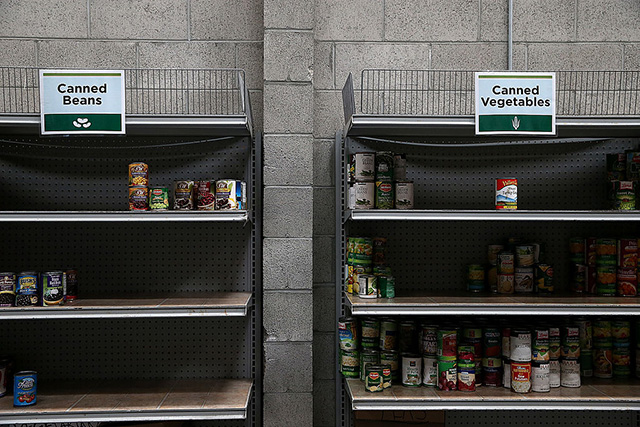
The White House has proposed cutting 25 percent of SNAP’s budget — about US $193 billion — over the next decade.
SNAP stands for Supplemental Nutrition Assistance Program, though it’s more widely known by its pre-2008 name, food stamps. This program helps about 44 million people per month buy food. Last year, the government spent $71 billion in total on the program.
SNAP serves the most vulnerable in our society, for whom a little money means a lot. According to the Congressional Budget Office, cuts to SNAP will likely have a major impact on the individuals who were hurt most by the recent recession.
As research from myself and many others shows, food assistance can have far-ranging impacts on a person’s health and well-being.
Served by SNAP
SNAP serves to dampen the effects of ups and downs of the economy. As a result, enrollment has been quite cyclical.
However, the number of people enrolled in SNAP is generally much lower than the number of people who are eligible. Throughout the program’s history, only about 30 percent of eligible elderly people actually participated in SNAP at any given time (though these rates have been higher recently). The share of individuals participating in SNAP closely follows changes in the share of unemployed.
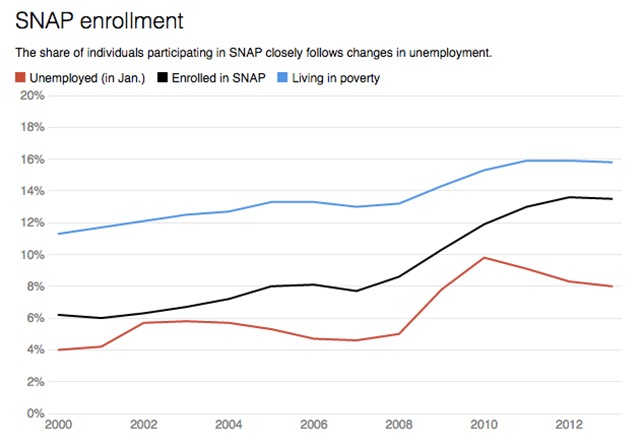 (Data: Bureau of Labor Statistics and US Census; Chart: The Conversation, CC-BY-ND.)
(Data: Bureau of Labor Statistics and US Census; Chart: The Conversation, CC-BY-ND.)
Enrolling in SNAP carries a stigma and can be quite costly in terms of time and effort for some individuals.
During the Great Recession, however, many states automatically enrolled people in SNAP when they signed up for other safety net programs. Some states waived the work requirements that had been introduced in 1996 or elevated the poverty threshold for eligibility.
As a result, program participation doubled, along with its cost. In 2006, 26.5 million people were enrolled, costing about $33 billion. The US hit a peak 47 million enrolled in 2013, with an $80 billion budget.
Despite the unemployment rate decreasing, both the share of people eligible for SNAP and share of people who are actually on SNAP are still quite high and are not coming down with the declining unemployment. This raises questions and makes the program more of a target for the small federal government conservatives.
Common Myths
There is a lot of misinformation in the media about SNAP. The program is portrayed as disincentivizing work and creating a culture of dependency. SNAP continues to serve children, elderly and the disabled, who constitute about 60 to 70 percent of participants. But, due to declining real wages and increased inequality during and after the Great Recession, SNAP increasingly operates like work support for the working poor. More than 20 percent of SNAP recipients work full-time, are caretakers or participate in a training program.
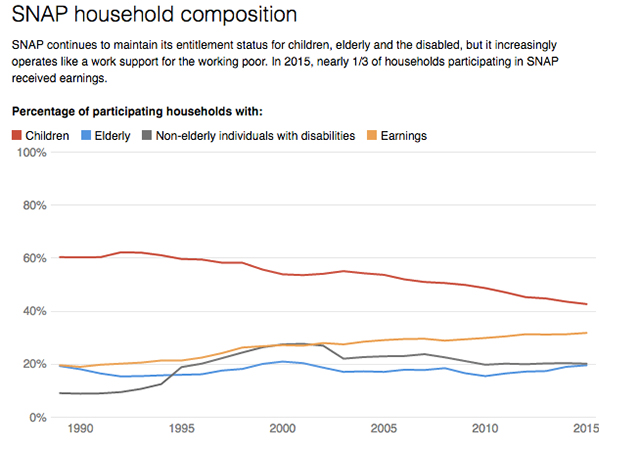 (Data: USDA; Chart: The Conversation, CC-BY-ND.)
(Data: USDA; Chart: The Conversation, CC-BY-ND.)
Today, most states are back to imposing work requirements and restricting eligibility for able-bodied adults. More than 75 percent of SNAP recipients live in a household where someone had a job in the year before or after receiving SNAP.
Most SNAP recipients live in households with very low income. The Federal Poverty Line is about $20,000 per year for a household of three. SNAP benefits boost the average recipient’s income by about 36 percent. This number may look big, but that amount per person on average is only about $125 per month, with maximum amount for the really poor only slightly more than this.
Many eligible individuals also use these programs for a limited period of time. About 30 percent remain in for less than 12 months.
Finally, despite myths about fraud, error rates are low. On average, SNAP overpays recipients only 3 percent of the time and underpays about 1 percent of the time, with very low fraud rates.
Hunger and Health
As of 2015, about 13.7 percent of US households had low or very low food security. Many did not have enough food and household members could not eat even when very hungry. Thirty percent went without food for a whole day.
This rate of food insecurity is as high as 20 percent in some states.
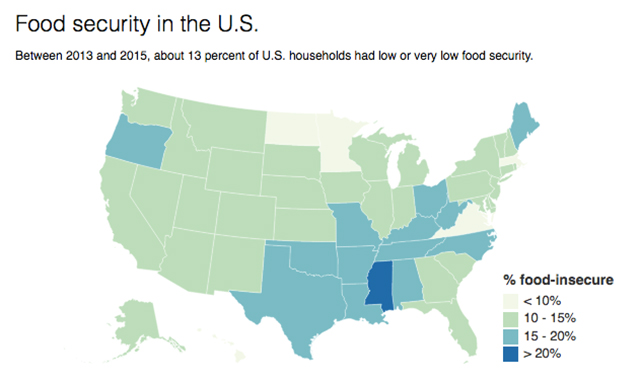 (Data: USDA; Chart: The Conversation, CC-BY-ND.)
(Data: USDA; Chart: The Conversation, CC-BY-ND.)
Low-income, food-insecure adults are more likely to postpone needed medical care or medications, use the emergency department and more become hospitalized.
What’s more, clinical studies show that people who go hungry over the long term are two to three times more likely to report severe blood sugar issues and . makes it harder to follow diet rules, which increases emotional stress.
Among pregnant women, food insecurity is associated with high rates of iron deficiency. That, in turn, can affect birth weight and neonatal cognitive development. Insufficient diet during pregnancy can also lead to higher risk of birth defects, and and at infancy can significantly affect education and labor market outcomes in the long run.
The Next 10 Years
SNAP has been successful at reducing food insecurity. Research suggests SNAP benefits reduce the likelihood of being food-insecure by roughly 30 percent.
This has far-reaching consequences for everyone, but especially children. Our research shows that kids who are not hungry do better in school, with higher test scores.
Other studies show that children without sufficient food have not only have significantly lower arithmetic scores, but are more likely to have repeated a grade, seen a psychologist or had difficulty getting along with other children. These problems are also more frequent for teenagers who don’t receive sufficient food.
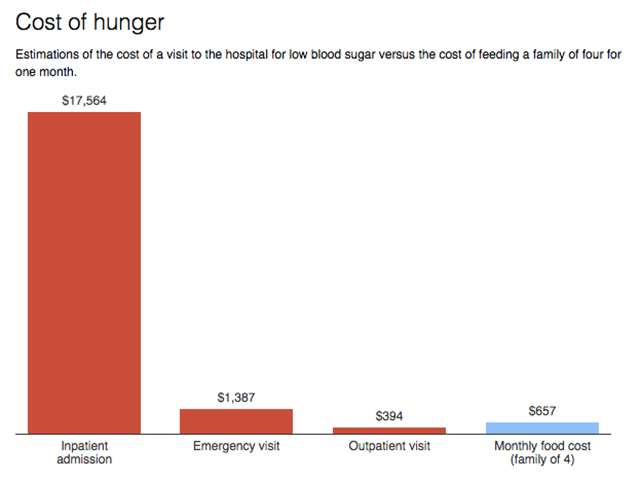 (Data: Hilary Seligman; Chart: The Conversation, CC-BY-ND.)
(Data: Hilary Seligman; Chart: The Conversation, CC-BY-ND.)
Meanwhile, disadvantaged children who receive food assistance experience — including reduced cases of obesity and diabetes — and economic self-sufficiency later in life, compared to similarly disadvantaged children who do not.
When considering the costs and benefits of this program, the calculations should be done with these facts in the balance. Making SNAP less accessible may mean not only major short-term impact to the most vulnerable but also very significant long-run effects.
It is hard perhaps for some to judge the benefits of having one less hungry person. But it is not hard to see the costs of a hungry one. If less hunger means fewer dropouts from school, less emergency room use and less crime, those are big gains for society.
![]()
Defying Trump’s right-wing agenda from Day One
Inauguration Day is coming up soon, and at Truthout, we plan to defy Trump’s right-wing agenda from Day One.
Looking to the first year of Trump’s presidency, we know that the most vulnerable among us will be harmed. Militarized policing in U.S. cities and at the borders will intensify. The climate crisis will deteriorate further. The erosion of free speech has already begun, and we anticipate more attacks on journalism.
It will be a terrifying four years to produce social justice-driven journalism. But we’re not falling to despair, because we know there are reasons to believe in our collective power.
The stories we publish at Truthout are part of the antidote to creeping authoritarianism. And this year, we promise we will kick into an even higher gear to give you truthful news that cuts against the disinformation, vitriol, hate and violence. We promise to publish analyses that will serve the needs of the movements we all rely on to survive the next four years, and even build for the future. We promise to be responsive, to recognize you as members of our community with a vital stake and voice in this work.
Please show your support for Truthout with a tax-deductible donation (either once today or on a monthly basis).